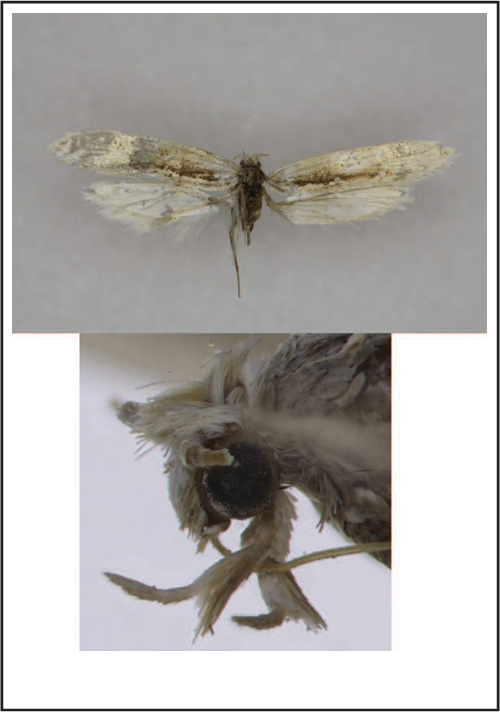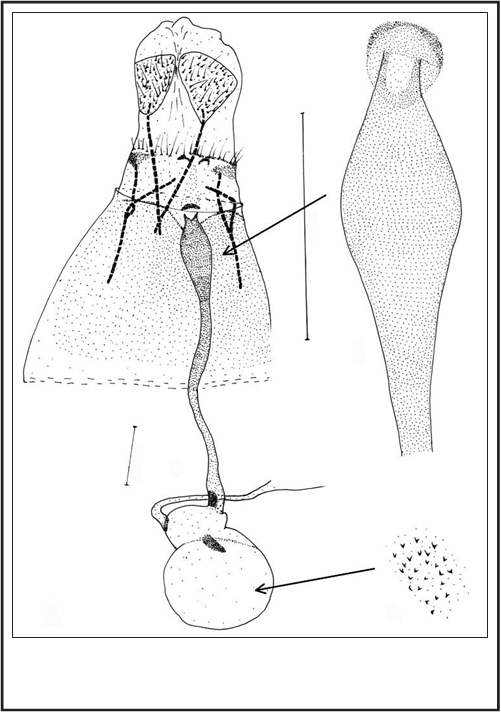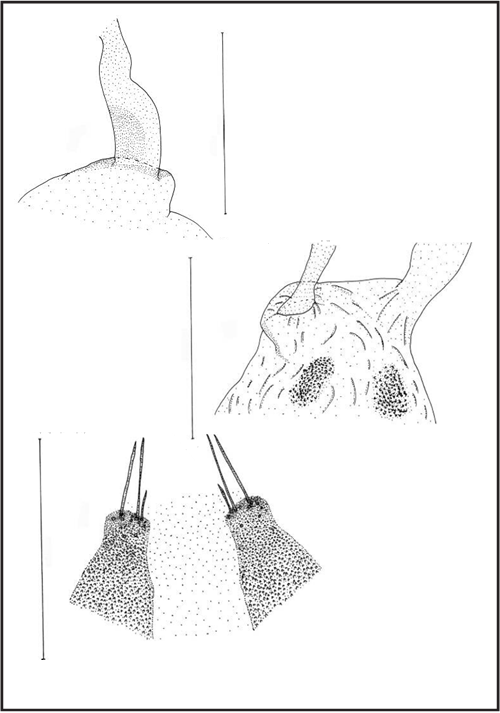

Description of a new Nepalese Rhigognostis Staudinger, 1857 species (Lepidoptera: Plutellidae)
Descripción de una nueva especie nepalesa de Rhigognostis Staudinger, 1857 (Lepidoptera: Plutellidae)
Description of a new Nepalese Rhigognostis Staudinger, 1857 species (Lepidoptera: Plutellidae)
SHILAP Revista de lepidopterología, vol. 44, núm. 175, 2016
Sociedad Hispano-Luso-Americana de Lepidopterología
Recepción: 02 Julio 2015
Aprobación: 15 Septiembre 2015
Abstract: Rhigognostis hausmanniella Baraniak, sp. n. described from the type specimen found at an elevation of 3950 m in the Annapurna massif in Nepal. The female genitalia are described in detail.
Keywords: Lepidoptera, Plutellidae, Rhigognostis hausmanniella, taxonomy, morphology, description, female genitalia, Nepal.
Resumen: Se describe Rhigognostis hausmanniella Baraniak, sp. n. sobre el ejemplar tipo encontrado a una altura de 3950 m en el macizo del Annapurna en Nepal. Se describe en detalle la genitalia de la hembra.
Palabras clave: Lepidoptera, Plutellidae, Rhigognostis hausmanniella, taxonomía, morfología, descripción, genitalia de la hembra, Nepal.
Introduction
In the Palaearctic area there are 9 known species of genus Rhigognostis Staudinger, 1857 (KYRKI, 1989, BARANIAK, 1992, 2015). Detailed faunistic data on the Nepalese Yponomeutoidea have been presented by MORIUTI (1965, 1971), and faunistic studies of Lepidoptera in Nepal have been summarized by ROBINSON et al. (1995). This applies also to Plutella viatica, described by DURRANT (1906) from Tibet. During my visit to the zoological museum in Munich (Zoologische Staatssammlung München) I found specimens collected by employees of the museum during expeditions in Nepal. The expeditions and their results have been described by DIERL (1966 a, b, 1971) and EBBERT (1966). However, the materials including butterflies of the family Yponomeutoidea come from later expeditions and have not been described in detail so far. Terminology for genitalia used in this paper follows KLOTS (1970), RAZOWSKI (2008) and ULENBERG (2009).
Systematics
Rhigognostis hausmanniella Baraniak sp. n. (Fig.1)
Holotype: 0, C-Nepal, Syang-Khola-Tal westl. Jomsom, 3950 m, 5-VII-1973, Dierl-Lehmann leg.
Statssig. Munchen, prep. gen. no YPO 74/2014 (Holotype in Zoologische Staatssammlung, Munich, Germany).
Locus typicus: The town of Jomsom (2600 m) is situated near the popular Annapurna Circuit trek route in the Annapurna massif with numerous peaks of 6000-8000 m. On the rocky slopes close to Syang there are only a few lone trees fighting for survival in this part of Nepal.
Wingspan: 20 mm. Head covered with erect, white scales; scanty light yellow scales visible only near compound eyes. Scapus and 3 preserved flagellomeres of antenna pure white. Labial palps (Fig. 2) composed of 3 segments; central segment longest, last segment curved, with a pointed apex. First segment covered with white scales, but scanty light yellow scales present near central segment base. Central segment white, scales forming a characteristic tuft, bicoloured: adhering scales white, other scales light yellow. Last segment covered with white scales and a small proportion of scattered light yellow scales. Maxillary palps white, thin, conspicuous, last segment pointed.
Forewing (Fig.1) basal area white, with a small proportion of scattered light brown scales. Costal margin, dorsal margin, and apical area white, with scattered brown scales. Close to basal area, at half of wing width, a thin irregular light brown patch with scattered white scales visible along wing axis. Constrictions visible on dorsal side. At wing apex a small yellow spot, composed of several light brown scales. Cilia long, white, with scattered darker scales. Hindwing white, with scattered darker scales on veins. Cilia long, pure white.
Female genitalia (Fig. 3): Papilla analis small, membranous, triangular in outline, with scanty hair- like spinules. Posterior and anterior apophyses long and thin. Antrum (Fig. 3b) extended, strongly sclerotized, narrow, with rounded edges, gently narrowing into ductus bursae. Ductus bursae initially similarly sclerotized, at half its length slightly constricted and clearly membranous. Dilated in its short section near inception of bursa copulatrix, on one side strengthened with spinules (Fig. 3d). Bursa copulatrix shape complicated, markedly dilated and irregular near ductus bursae and ductus bullae, remaining part spherical. Bursa copulatrix membranous, with spinules on its walls (Fig 3 c). Signum (Fig. 3e) composed of 2 large, elongate-oval sclerites lying close to each other. Ductus bullae narrow, membranous, short, broadening into a small, elongated, membranous bulla seminalis. Ductus seminalis narrow, membranous.
Male, biology and habitat unknown.
Remarks: Rhigognostis hausmanniella can be easily distinguished from other species of this genus by morphological features. None of the species described so far has white forewings, and the light brown streak, extending from wing base to apex, is characteristically curved but very thin. In other species, forms with predominantly white wing background, found in R. senilella (Zetterstedt, 1840) and R. marmorosella (Wocke, 1850), wings always have more or less conspicuous grey or brown patches or bands.
The structure of female genitalia, and of antrum in particular, distinguishes this species from all the other species reported so far. Its antrum is narrow and extended, while in the others it is initially broadly dilated and characteristically constricted near ductus bursae. Bursa copulatrix of the new species is similar in structure to that of R. marmorosella but is distinguished by a signum composed of 2 large, elongate-oval sclerites, lying close to each other, whereas in bursa copulatrix of R. marmorosella, signum is absent.
Etymology: The name of this species is a dedicated to the famous German lepidopterologists Axel Hausmann, in honour of his achievements in the taxonomy o Lepidoptera mostly Geometridae.



Agradecimientos
This study was supported by the Polish Ministry of Sciences and Higher Education (grant no. NN303 568538). I would like to express special thanks to Dr Axel Hausmann (Zoologische Staatssammlung, Munich, Germany) for the loan of the specimen for this study. Partial translation of the manuscript into English by Sylwia Ufnalska, is gratefully acknowledged.
BIBLIOGRAPHY
BARANIAK E., 1992.– Gatunki z rodzaju Rhigognostis Staudinger, 1857 (Lepidoptera, Plutellidae) w Polsce.–Wiadomotci entomologiczne, 11(3): 161-167.
BARANIAK, E., 2015.– Rhigognostis senilella (Zetterstedt, 1839) and R. marmorosella (Wocke, 1849): two valid species distinguishable in the genitalia of both sexes (Lepidoptera, Plutellidae).– Zootaxa, in press.
DIERL, W., 1966a.– Zur Kenntnis der Hauptbiotope des Expeditionsgebietes Khumbu Himal vom Gesichtpunkt des Entomologen (Nepal Expedition 1964).– Khumbu Kimal, .:142-171.
DIERL, W., 1966b.– Psychidae aus Nepal.– Khumbu Kimal, .: 332-342.
DIERL, W., 1971.– Biologie und Systematik einiger Asiatischer Psychidae-Arten (Lepidoptera).– Khumbu Kimal, .: 58-79.
DURANT, J. H., 1906.– Tineina.– In H. J. ELWES, G. HAMPSON & J. H. DURRANT. On the Lepidoptera collected by the Officers on the recent Tibet Frontier Commission.– Proceeding of the Zoological Society of London, 33: 496-498.
EBERT, G., 1966.– Beiträge zur Kenntnis der Entomologischen Sammelgebiete der Nepal-Expedition 1962.–Khumbu Kimal, .: 121-141.
KLOTS, A. B., 1970.– Lepidoptera.– In S. L. TUXEN (Ed). Taxonomist’s Glossary of genitalia in insects: 115-129. Skandinavian University Books, Munksgaard, Copenhagen.
KYRKI, J., 1989.– Reassessmant of the genus RhigognostisZeller, with descriptions of two new and notes on further seven Palaearctic species (Lepidoptera: Plutellidae).– Entomologica scandinavica, 19: 437-453.
MORIUTI, S., 1965.– Studies on the Yponomeutoidea (XI). Two new species of Pseudocalantica Friese (Lepidoptera, Yponomeutidae) from Nepal.– Kontyû, 33: 7-10.
MORIUTI, S., 1971.– A revision of the world species of Thecobathra (Lepidoptera, Yponomeutidae).– Kontyû, 39: 230-251.
ROBINSON, G. S., SATTLER, K., SHAFFER, M., TUCK, K. R. & ALLEN, M. G., 1995.– Microlepidoptera and Pyraloidea of Nepal - a checklist and bibliography.– Tinea, 14, suppl. 2: 150-181.
RAZOWSKI, J., 2008.– Tortricidae (Lepidoptera) of the Palaearctic Region. General Part and Tortricini, .: 152 pp. Frantisek Slamka, Kraków - Bratislava.
ULENBERG, S. A., 2009.– Phylogeny of the Yponomeutaspecies (Lepidoptera, Yponomeutidae) and the history of their host plant associations.– Tijdschrift voor Entomologie, 152: 187-207, Figs 1-5, Tables 1-5.